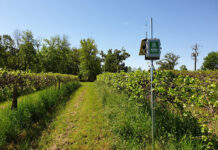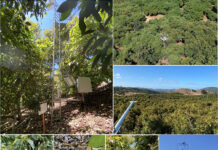Imperial County, located in Southern California, has a large agricultural sector with close to 500,000 acres in production. The region’s major agricultural sectors are cattle feedlots, forages and vegetables. Imperial County and surrounding areas produce an estimated two-thirds of the nation’s vegetables in the winter. In the last decade, the use of pressurized irrigation systems (solid set sprinklers and drip irrigation) and wider beds in vegetable production has gained popularity in Imperial County. Imperial County is a top fresh market onion region with over 3,000 acres in annual production. Agriculture in Imperial County relies on just one water source: the Colorado River. As the Colorado River basin (CRB) is reaching more than 20 years of continuous drought, the US Bureau of Reclamation is working with basin users to develop strategies that may reduce water usage between 2 and 4 million acre-feet per year. Most of the projected water cuts are expected from agriculture due to its high share of water use. Agricultural users and water regulators in the CRB are discussing strategies to promote water conservation practices and improve water use efficiency while keeping a large and productive agricultural sector that feeds Americans with high-quality food all year long. The objective of this study was to assess the effect of two bed sizes and two irrigation amounts on onion yield and water productivity.


Methods
This study was performed during two growing seasons (2019-20 and 2020-21) at the UC Desert Research and Extension Center (DREC) in Holtville, Calif. The major soil unit in testing areas is a Holtville clay with clay, silt and sand proportions of approximately 42%, 19% and 39%, respectively.

Two irrigation levels were evaluated: 100% and 130% of crop evapotranspiration (ETc). ETc was computed using potential evapotranspiration from the California Irrigation Management Information Systems (CIMIS) station at DREC (Meloland station #87) and adjusted by stage-specific crop coefficients (Table 1) developed by Ali Montazar (2019) for Imperial County onion production. This study used sprinkler irrigation for crop emergence and until the beginning of bulbing to ensure an adequate establishment. This is a normal practice in our region. Irrigation treatments using drip systems were established in January of every season. Water amounts delivered through the drip irrigation system were computed using a daily water balance approach (irrigation needs = ETc – rainfall). Drip irrigation treatments started at bulb initiation (about eight leaves and a bulb diameter that was twice that of the neck.) Onion yields and sized distribution were measured at harvest. A two-sample t-test was performed to compare irrigation levels per bed size with SAS software. Total water productivity (TWP) was computed for each irrigation treatment. The TWP included rain and irrigation amounts. The TWP was computed as the total fresh onion yield divided by the total water use.
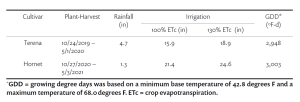
The drip tape was installed between 2- and 4-inches depth. One drip tape line was installed near the center of the 40-inch bed. Three drip tape lines were buried in the 80-inch bed plots. 4 and 12 lines of onions were planted in the 40-inch and 80-inch bed rows, respectively. Research plots were 50 feet long and comprised four rows on 40-inch beds and three rows on 80-inch beds.
Results and Discussion
Table 2 shows onion cultivars, seasonal conditions and irrigation amounts per season. Terena and Hornet varieties are short-day, yellow hybrid onions (Figure 1). Terena variety has a globe shape and Hornet is a grano-shaped onion.
Plant density used in this study is in the range used by growers in Imperial County (Table 3). Plant density on 80-inch beds was about 50% higher than onions planted on 40-inch beds.
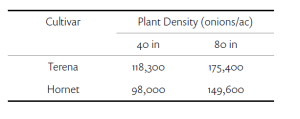
Total yields responded to irrigation amounts except in the trial with Hornet (2020-21) on 80-inch beds (Table 4). In the Hornet trial (2020-21) on 80-inch beds, we noticed the irrigation treatment using 130% ETc yielded a higher proportion of pre-pack sizes compared to other treatments. We also noticed Hornet grown on 80-inch beds did not yield super colossal sizes. These results indicate Hornet seeds were planted too close in the 80-inch beds, reducing bulb size in the higher-irrigation treatment.
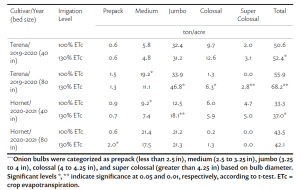
Terena treatments in 2019-20 produced a larger proportion (63% to 90%) of high-value bulbs (jumbo, colossal and super colossal) than Hornet in 2020-21(49% to 78%). High-value bulbs produced by irrigation treatments at 130% ETc were consistently higher than in the 100% ETc treatments. When onions were sorted by sizes and per-unit yields were computed, Terena’s yields were approximately 20% higher than Hornet’s yields.
Irrigation levels did not affect total water productivity (TWP) for Terena (2019-20) grown on 80-inch beds and Hornet (2020-2021) grown on 40-inch beds (Table 5). Total water productivity decreased as irrigation increased in the following trials: Terena (2019-20) on 40-inch beds and Hornet (2020-21) on 80-inch beds. Total yields on 80-inch beds increased between 10% and 31% compared to total yields on 40-inch beds (Table 5). Total water productivity was higher when onions were harvested on 80-inch beds than onions produced on 40-inch bed systems. Total water productivity of onions using 80-inch beds increased between 8% and 32% compared to onions grown on 40-inch beds.

Highlights
Terena variety produced higher yields than Hornet variety.
High-value bulbs (jumbo, colossal and super colossal) produced by irrigation treatments at 130% ETc were consistently higher than with 100% ETc.
Total water productivity did not increase as irrigation levels increased regardless of bed size.
Fresh market onions on 80-inch beds were more water efficient than onions produced using 40-inch beds.
References
Montazar, A. 2019. Preliminary estimation of dehydrator onion crop water needs in the Imperial Valley. Agricultural Briefs 22(7):131-135. University of California Cooperative Extension – Imperial County.
This research included funds from the California Department of Food and Agriculture’s Fertilizer Research and Education Program.
For more information, contact Jairo Diaz at jdiazr@ucanr.edu or 760-791-0521.





